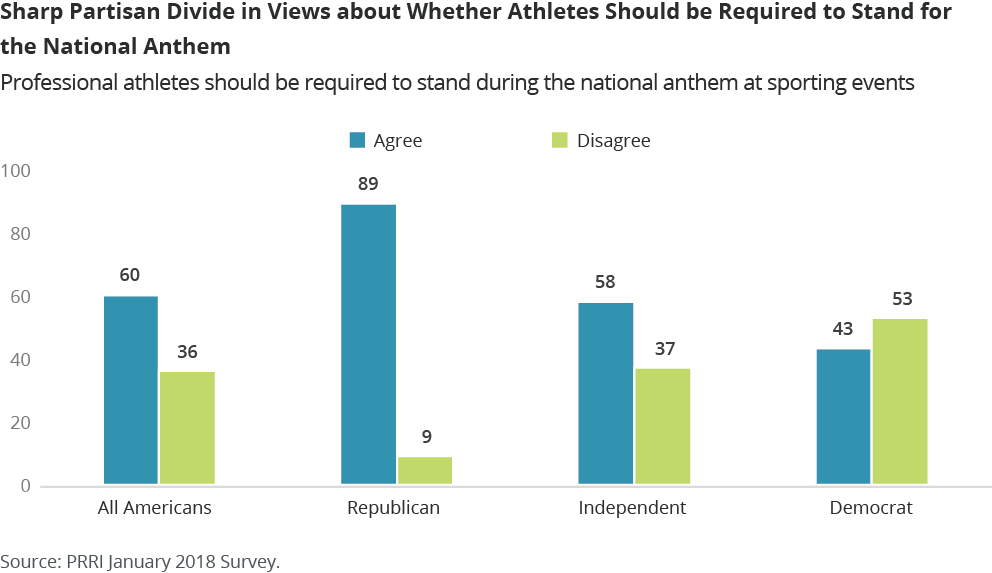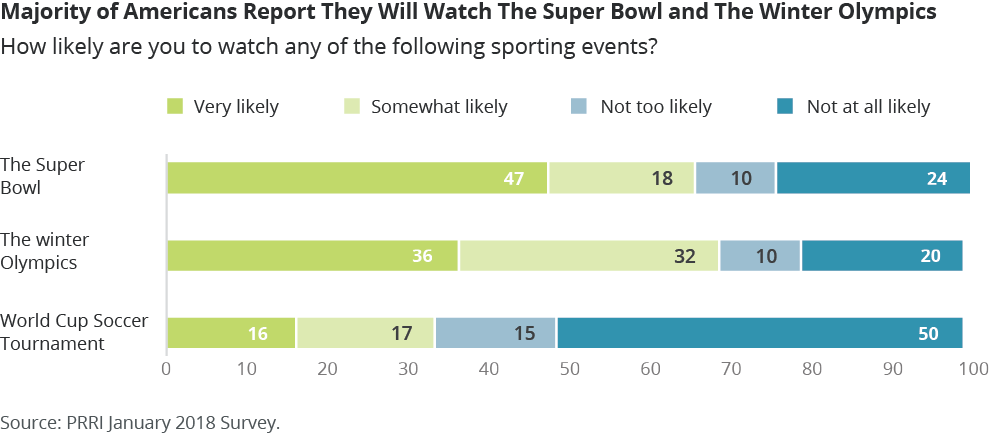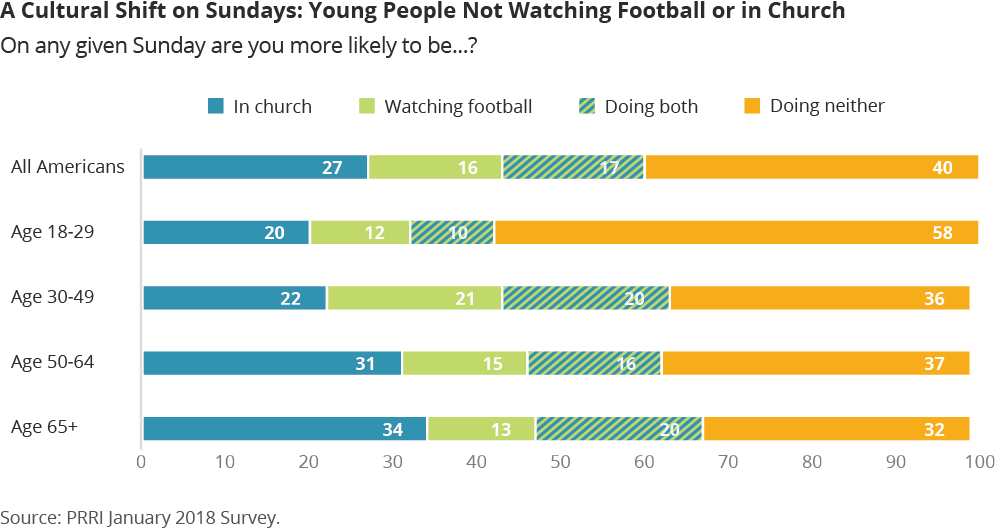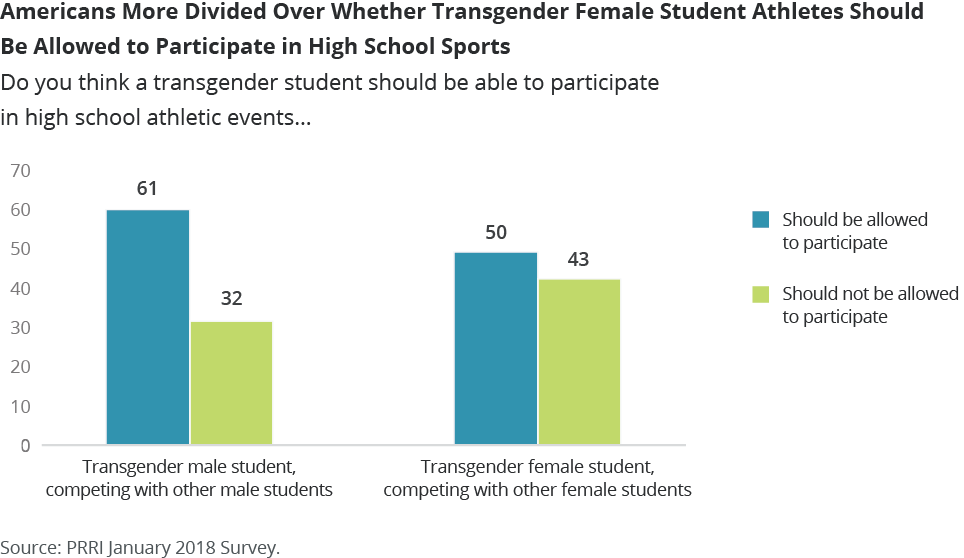Americans Differ on Participation of Male, Female Transgender Students in Team Sports
Sports in American Culture: Popularity, Value, and Risk
Favorite Sport to Watch
Football remains America’s most popular sport to watch. Nearly four in ten (38%) Americans say football is their favorite sport to watch—about the same number as those who prefer baseball (12%), basketball (10%), soccer (9%), ice hockey (5%), and auto racing (5%) combined. Notably, 15% of Americans say they do not have a favorite sport, or do not watch sports at all. Americans’ preference for football is virtually unchanged since 2014, when 39% of the public said football was their favorite sport to watch.
Preferences vary considerably between Americans of different racial and ethnic backgrounds. A majority (51%) of black Americans say that football is their favorite sport to watch, and about one-quarter (24%) say that basketball is their favorite sport to watch. About four in ten (38%) white Americans report that football is their favorite sport, and 14% say the same about baseball.1 Football is also mentioned more often by Hispanic Americans than any other sport. One-third (33%) of Hispanic Americans say football is their favorite sport, while about one in four (24%) say they most like to watch soccer.
Similar numbers of men (39%) and women (37%) name football as their favorite sport to watch. While women are more likely than men to say that basketball is their favorite (13% vs. 7%, respectively), they are also more likely to say that they do not have a favorite sport or do not watch sports (19% vs. 11%, respectively).
Childhood Sports
Although baseball is not the most popular sport to watch, it is still the game that most Americans played as children. One in four (25%) Americans report playing baseball or softball most often while growing up. Fewer Americans report playing basketball (14%), soccer (12%), or football (11%) most often. Less than one in ten Americans say the sport they played most often when they were young was volleyball (9%), track and cross country (7%), or tennis (5%). More than one in ten (12%) Americans report that they did not participate in youth sports.
Soccer is uniquely popular among young Americans (age 18-29), who are more than ten times as likely as seniors (age 65+) to list soccer as the sport they played most during childhood. More than one in five (22%) young Americans and only two percent of seniors report that soccer is the primary sport they played during their childhood. More than one in three (36%) seniors say they played baseball or softball most when they were young, compared to fewer than one in five (18%) young Americans.
The popularity of childhood sports is also segmented by race and ethnicity. White Americans are more likely to report playing baseball most when they were young (28%), compared to about two in ten Hispanic (20%) or black (18%) Americans. Nearly three in ten (28%) black Americans report they played basketball most while growing up, compared to 14% of Hispanic and 12% of white Americans. Hispanic Americans are unique in their affiliation with soccer, with three in ten (30%) saying that soccer is the game they played most while growing up. Fewer than one in ten white (nine percent) and black (four percent) Americans say the same.
Competitive Sports Viewed as Equally Valuable for Boys’ and Girls’ Development
Americans are as likely to say that competitive sports are important for the physical and emotional development of young women as they are of young men. More than eight in ten Americans affirm the importance of playing competitive sports for both young men and young women (83% and 85%, respectively).
Notably, men and women answer these questions very similarly. Roughly equal numbers of men and women say that competitive sports are important for the emotional and physical development of young women (86% and 84%, respectively) and young men (84% and 82%, respectively).
Allowing Your Son to Play Football
Despite ongoing concerns about the risk of head injury in football, most Americans would not prohibit their son from playing the sport. More than seven in ten (71%) Americans say they would allow their son to play competitive football, while 27% say they would not. In 2014, only 22% of the public said they would keep their son from playing football.
White Americans are significantly more likely than nonwhite Americans to say that they would not allow their young son to play competitive football. Nearly one-third (32%) of white Americans say they would not allow it, compared to 22% of black and 13% of Hispanic Americans.
Among white Americans, willingness to let their son play football differs substantially by education level and party. Whites with a college degree are much more likely than those without a college degree to say they would not allow their son to play football (41% vs. 27%, respectively). Although there are no differences in the likelihood of Democrats and Republicans overall to prohibit their son from playing competitive football (31% vs. 30%, respectively), nearly half (48%) of white Democrats say they would not it, while only 31% of white Republicans say the same.
Interest in the Super Bowl, Olympics, and World Cup
Among three of the most anticipated sporting events this year—the Super Bowl, the Winter Olympics, and the Men’s World Cup Soccer Tournament—the Super Bowl remains the most popular. Nearly two-thirds (65%) of Americans say they are likely to watch the Super Bowl, including about half (47%) who say they are very likely to tune in. A similar number of Americans (68%) say they are likely to watch the Winter Olympics—although only about one-third (36%) of Americans say they are very likely to watch. Only one in three (33%) Americans report that they are likely to watch the World Cup. But although this year’s tournament will not feature the U.S. men’s national team, slightly more Americans are planning to watch the World Cup this year than in 2014, when 27% said they were likely to watch. Interest in the Winter Olympics and the Super Bowl has not changed significantly from previous years.
The likelihood of watching any of these sporting events varies significantly by race and ethnicity. Nearly two-thirds (65%) of black Americans say they are very likely to watch the Super Bowl, while fewer than half of Hispanic (45%) and white (43%) Americans say the same. About four in ten (41%) white Americans are very likely to watch the Olympics, more than the number of Hispanic (30%) and black (23%) Americans who report the same. Finally, while close to four in ten (37%) Hispanic Americans say they are very likely to watch the World Cup this year, only 15% of black and 11% of white Americans say the same.
Most Americans are not worried by the Olympics’ being held in South Korea, despite ongoing tensions between the U.S. and North Korea. Only 33% say they are somewhat or very worried. Roughly two-thirds (66%) say they are not too worried or not at all worried about this.
There are notable differences across generations in the level of concern about where the Olympics are being held. More than four in ten (41%) seniors say they are worried about the location, while only one-quarter (25%) of young Americans say the same.
Women are significantly more concerned about the location of the Olympics this year than men. More than four in ten (41%) women report being at least somewhat concerned about the Winter Olympics’ location, while only one-quarter (25%) of men say the same.
A Cultural Shift on Sundays: Football or Church?
America’s historically most popular Sunday activities—watching football and going to church—are still fairly common, although few report doing both. On any given Sunday, 27% of Americans say they are more likely to be in church than watching football, while 16% say the opposite—that they are more likely to be watching the game. Seventeen percent of the public say they are likely to be doing both on Sundays. Forty percent say they are unlikely to be doing either.
Sunday activities vary dramatically by age. A majority of seniors say they are more likely to be in church (34%), or both attending services and watching football (20%). Three in ten young adults say that they are more likely to be in church (20%), or both attending services and watching football (10%). Nearly six in ten (58%) young people say they are not likely to be doing either.
There is also a sizable gender gap. Men are about as likely to be in church on a given Sunday as to be watching football (22% vs. 19%, respectively), while women are far more likely to be attending services (31%) than watching football (13%).
Professional Sports, Protests, and Politics
Most Americans do not have a problem with professional athletes’ making public statements about political issues. A majority (54%) of the public say they are not bothered when athletes take political stands, although nearly four in ten (39%) say it does bother them.
There is significant partisan disagreement, however: Republicans are far more likely than Democrats to express discomfort with professional athletes’ making political statements (62% vs. 25%, respectively). Independents generally resemble the public overall.
Controversy Over the National Anthem
Most Americans believe that professional athletes should be required to stand during the national anthem. Six in ten (60%) agree that professional athletes should not be allowed to kneel while the national anthem is being played, while 36% oppose this requirement. But opinion is stratified by political affiliation and age.
Republicans are more than twice as likely as Democrats to support a requirement that professional athletes stand during the anthem (89% vs. 43%, respectively). A majority (53%) of Democrats reject this idea. Political independents closely mirror the public overall.

There is also substantial disagreement across generations. More than seven in ten (72%) seniors say professional athletes should be required to stand during the national anthem, while fewer than half (44%) of young people agree. A slim majority (51%) of young adults say professional athletes should not have to stand for the anthem.
Americans are largely aware that professional athletes first started kneeling during the anthem to protest police violence against African Americans. Nearly two-thirds (65%) of the public identify this as the original motivation for the national anthem protests. Only 13% say these protests are in opposition to the election of Donald Trump, and eight percent say they are a response to negative treatment of players by the NFL management.
There is general agreement across the political divide. Similar numbers of Republicans (63%), Democrats (67%) and independents (70%) say the national anthem protests started over the issue of police treatment of African Americans.
But there are substantial divisions in perceptions of the athletes’ motivation by race/ethnicity and education. Roughly seven in ten white (71%) and black (68%) Americans say the anthem protests are about police treatment of African Americans, while only 47% of Hispanics say the same. Twenty percent of Hispanics say the protests started in response to Donald Trump’s election, 11% say it was a response to NFL management, and 19% say they do not know. Whites with a four-year college degree are much more likely than those without (83% vs. 63%) to say athletes began kneeling to raise awareness of how police treat African Americans.
Transgender Students and Sports
Transgender Students and High School Athletics
Americans express differing opinions about whether transgender students should be permitted to participate in high school sports. Roughly six in ten (61%) say that a transgender student who was listed as female on their birth certificate, but who now identifies as male, should be allowed to participate with other male students in high school sports. Approximately one-third (32%) say they should not be allowed to participate.
However, Americans are much more divided when it comes to students who were listed as male on their birth certificate but who now identify as female. Half (50%) of the public believe that these students should be allowed to participate in sporting events with their female classmates. Forty-three percent of Americans are opposed.
Notably, while Democrats and Republicans disagree sharply on this issue, their views do not change with respect to the transgender student’s gender identity. Nearly identical numbers of Democrats support allowing female (73%) and male (74%) transgender students to participate with their female and male classmates, respectively. In contrast, relatively few Republicans favor allowing transgender female (30%) or male (37%) students to participate in high school athletic events with other female and male students. Political independents, however, draw sharp distinctions between transgender male and female students. More than six in ten (63%) independents say that a transgender student who was listed as female at birth, but who now identifies as male, should be allowed to participate in sports with other male students, while only 46% say that a female transgender student who was listed as male at birth, but now identifies as female, should be allowed to participate with other female students.
Are Colleges Investing Too Much in Athletics?
Most Americans believe that colleges and universities are spending too much on sports at the expense of academics. Nearly six in ten (58%) agree with this statement, while roughly one-third (35%) disagree.
There are notable differences in opinion by race and ethnicity. More than six in ten (62%) white Americans agree that colleges are investing too many resources in their sports programs, while fewer than half of black (49%) and Hispanic (46%) Americans agree.
College graduates are also more likely than Americans without any college experience (65% vs. 55%, respectively) to agree that colleges and universities spend too much on athletic programs and too little on academics.
Endnote
1 Here and throughout the report, “white” and “black” refer to those who do not identify as Hispanic.
Recommended Citation
Jones, Robert P., Daniel Cox, and Rob Griffin. “Americans Differ on Participation of Male, Female Transgender Students in Team Sports.” PRRI. 2018.
Featured image by Brian Beaulieu Photography.







